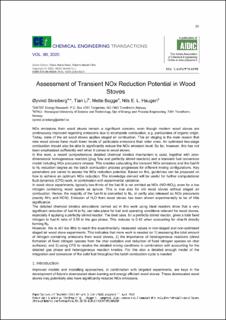| dc.description.abstract | NOx emissions from wood stoves remain a significant concern, even though modern wood stoves are continuously improved regarding emissions due to incomplete combustion, e.g. particulates of organic origin. Today, state of the art wood stoves applies staged air combustion. This air staging is the main reason that new wood stoves have much lower levels of particulate emissions than older ones. An optimized two-stage combustion should also be able to significantly reduce the NOx emission level. So far, however, this has not been emphasized sufficiently well when it comes to wood stoves.
In this work, a recent comprehensive detailed chemical kinetics mechanism is used, together with zero-dimensional homogeneous reactors (plug flow and perfectly stirred reactors) and a transient fuel conversion model including NOx precursors release. This enables calculating the transient NOx emissions and the fuel-N to N2 reduction degree as the batch combustion process progresses for different mixing configurations. Key parameters are varied to assess the NOx reduction potential. Based on this, guidelines can be proposed on how to achieve an optimum NOx reduction. The knowledge derived will be useful for further computational fluid dynamics (CFD) work, in combination with experimental validation.
In wood stove experiments, typically two-thirds of the fuel-N is not emitted as NOx (NO+NO2), even for a low nitrogen containing wood specie as spruce. This is true also for old wood stoves without staged air combustion. Hence, the majority of the fuel-N is converted to N2, or partly also released as NOx precursors (mainly NH3 and HCN). Emission of N2O from wood stoves has been shown experimentally to be of little significance.
The detailed chemical kinetics simulations carried out in this work using ideal reactors show that a very significant reduction of fuel-N to N2 can take place for fuel and operating conditions relevant for wood stoves, especially if applying a perfectly stirred reactor. The best case, for a perfectly stirred reactor, gives a total fixed nitrogen to fuel-N ratio of 0.55 in the gas phase. This reduces to 0.45 when accounting for char-N directly forming N2.
However, this is still too little to reach the experimentally measured values in non-staged and non-optimised staged air wood stove experiments. This indicates that more work is needed on 1) assessing the total amount of nitrogen containing emissions from wood stoves, 2) the importance of heterogeneous reactions (direct formation of fixed nitrogen species from the char oxidation and reduction of fixed nitrogen species on char surfaces), and 3) using CFD to resolve the detailed mixing conditions in combination with accounting for the detailed gas phase and heterogeneous reaction kinetics. For this also a detailed enough model of the integration and conversion of the solid fuel throughout the batch combustion cycle is needed. | en_US |
